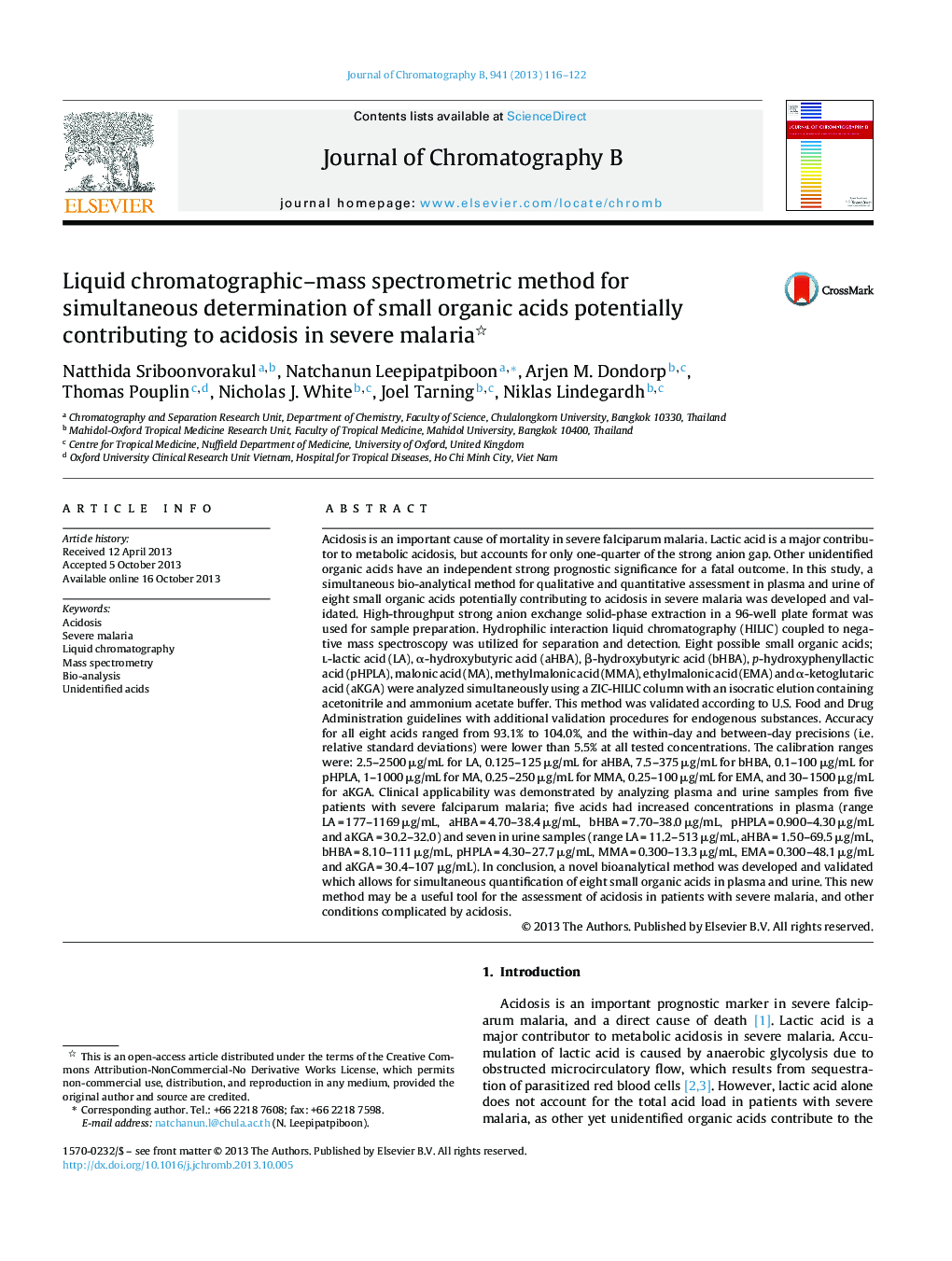| کد مقاله | کد نشریه | سال انتشار | مقاله انگلیسی | نسخه تمام متن |
|---|---|---|---|---|
| 7618027 | 1494095 | 2013 | 7 صفحه PDF | دانلود رایگان |
عنوان انگلیسی مقاله ISI
Liquid chromatographic-mass spectrometric method for simultaneous determination of small organic acids potentially contributing to acidosis in severe malaria
ترجمه فارسی عنوان
روش اسپکترومتری متشکل از کروماتوگرافی مایع برای تعیین همزمان اسیدهای کوچک ارگانیک به طور بالقوه به اسیدوز در مالاریای شدید
دانلود مقاله + سفارش ترجمه
دانلود مقاله ISI انگلیسی
رایگان برای ایرانیان
کلمات کلیدی
اسیدوزی، مالاریای شدید، کروماتوگرافی مایع طیف سنجی جرمی، تجزیه و تحلیل بیولوژیکی، اسید ناشناخته،
موضوعات مرتبط
مهندسی و علوم پایه
شیمی
شیمی آنالیزی یا شیمی تجزیه
چکیده انگلیسی
Acidosis is an important cause of mortality in severe falciparum malaria. Lactic acid is a major contributor to metabolic acidosis, but accounts for only one-quarter of the strong anion gap. Other unidentified organic acids have an independent strong prognostic significance for a fatal outcome. In this study, a simultaneous bio-analytical method for qualitative and quantitative assessment in plasma and urine of eight small organic acids potentially contributing to acidosis in severe malaria was developed and validated. High-throughput strong anion exchange solid-phase extraction in a 96-well plate format was used for sample preparation. Hydrophilic interaction liquid chromatography (HILIC) coupled to negative mass spectroscopy was utilized for separation and detection. Eight possible small organic acids; l-lactic acid (LA), α-hydroxybutyric acid (aHBA), β-hydroxybutyric acid (bHBA), p-hydroxyphenyllactic acid (pHPLA), malonic acid (MA), methylmalonic acid (MMA), ethylmalonic acid (EMA) and α-ketoglutaric acid (aKGA) were analyzed simultaneously using a ZIC-HILIC column with an isocratic elution containing acetonitrile and ammonium acetate buffer. This method was validated according to U.S. Food and Drug Administration guidelines with additional validation procedures for endogenous substances. Accuracy for all eight acids ranged from 93.1% to 104.0%, and the within-day and between-day precisions (i.e. relative standard deviations) were lower than 5.5% at all tested concentrations. The calibration ranges were: 2.5-2500 μg/mL for LA, 0.125-125 μg/mL for aHBA, 7.5-375 μg/mL for bHBA, 0.1-100 μg/mL for pHPLA, 1-1000 μg/mL for MA, 0.25-250 μg/mL for MMA, 0.25-100 μg/mL for EMA, and 30-1500 μg/mL for aKGA. Clinical applicability was demonstrated by analyzing plasma and urine samples from five patients with severe falciparum malaria; five acids had increased concentrations in plasma (range LA = 177-1169 μg/mL, aHBA = 4.70-38.4 μg/mL, bHBA = 7.70-38.0 μg/mL, pHPLA = 0.900-4.30 μg/mL and aKGA = 30.2-32.0) and seven in urine samples (range LA = 11.2-513 μg/mL, aHBA = 1.50-69.5 μg/mL, bHBA = 8.10-111 μg/mL, pHPLA = 4.30-27.7 μg/mL, MMA = 0.300-13.3 μg/mL, EMA = 0.300-48.1 μg/mL and aKGA = 30.4-107 μg/mL). In conclusion, a novel bioanalytical method was developed and validated which allows for simultaneous quantification of eight small organic acids in plasma and urine. This new method may be a useful tool for the assessment of acidosis in patients with severe malaria, and other conditions complicated by acidosis.
ناشر
Database: Elsevier - ScienceDirect (ساینس دایرکت)
Journal: Journal of Chromatography B - Volume 941, 15 December 2013, Pages 116-122
Journal: Journal of Chromatography B - Volume 941, 15 December 2013, Pages 116-122
نویسندگان
Natthida Sriboonvorakul, Natchanun Leepipatpiboon, Arjen M. Dondorp, Thomas Pouplin, Nicholas J. White, Joel Tarning, Niklas Lindegardh,
